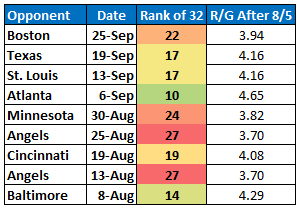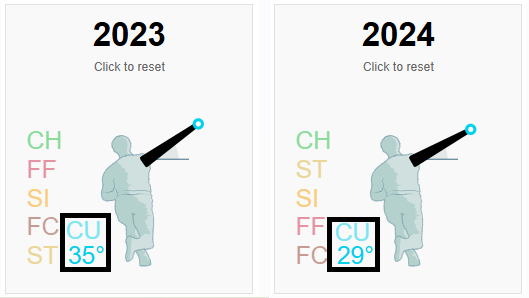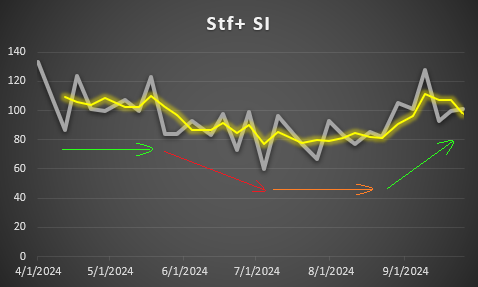Jarod's starting pitcher fantasy baseball busts and fallers with decreased K-BB% year over year. These are SP fantasy baseball draft avoids for 2025 drafts.
As managers prepare for their 2025 fantasy baseball drafts, we attempt to provide you with articles that offer a reason to draft a player ahead of their ADP, or in some cases, give you a reason to steer clear. This article illuminates a few starting pitchers and why their sudden drop in K-BB% is concerning (or not). Also, make sure to check out my other article on this topic Fantasy Baseball Starting Pitcher Risers (K-BB%) as well.
Before we dig in, if you're unsure why we're looking at K-BB%, then read this article by our very own Nick Mariano. To summarize, when viewing pitchers through this lens rather than ERA, for example, we're focusing more on what pitchers can control, rather than a generic stat.
As always, don't use stats in a vacuum, and instead use them to complete a well-rounded view of a player. Finally, note that for this exercise, only starting pitchers with a minimum of 50 innings pitched were used as the universe of players analyzed. Let's see who had the biggest drops in K-BB% from 2023 to 2024.
Be sure to check all of our fantasy baseball lineup tools and resources:- Fantasy baseball trade analyzer
- BvP matchups data (Batter vs. Pitcher)
- PvB matchups data (Pitcher vs. Batter)
- Who should I start? Fantasy baseball comparisons
- Daily MLB starting lineups
- Fantasy baseball closer depth charts
- Fantasy Baseball live scoreboard
- Fantasy baseball injury reports
Kevin Gausman, Toronto Blue Jays
-9.9 percent drop in K-BB%
Kevin Gausman had been aging like fine wine, getting better as he got older, earning his first All-Star selection in 2021 at the age of 30 and his highest Cy Young finish ever (third) in 2023 at the age of 32.
Last season's numbers don't look nearly as good as they had over the last several seasons, posting a 3.83 ERA, 1.22 WHIP, and a K-BB% of 14.0 percent. The veteran still managed to pick up 14 wins, though, and many will point to his late-season surge as a sign that he got stronger as the season went on. But did he?
Looking at the below table, you'll see that the former first-round draft pick's ERA, WHIP, and FIP all improved considerably over his final nine starts of the season, while fastball velocity (vFA) remained virtually unchanged.

However, looking at other peripheral stats, many ran counter to the outcome. Breaking down the next table, you see that over those final nine starts, xFIP and SIERA are both well above his ERA during that time and well above what they were earlier in the season.

Also, the strikeout rate went down and the walk rate went up, leading to a poor 10.3 percent K-BB%, which was 5.3 percent below where it was through August 2.
This last table further backs up what we're seeing, which is that there was a slight dip in how much he was in the zone and that there were fewer swings and misses. With a career BABIP of .311, a .233 BABIP over those last nine starts could indicate maybe he was on the lucky side of things.

Finally, the super-low 2.8 percent HR/FB%, compared to a career rate of 12.0 percent, likely helps explain how he was able to strand runners (LOB%) later in the season despite the lower strikeout rate.
What may also help explain the 6-foot-2 hurler's late-season effectiveness is that he simply didn't face formidable offenses down the stretch. The below table shows that seven of his last nine opponents were in the bottom half of the league in terms of scoring runs per game after August 5.

In summary, even though the ERA and WHIP looked good late, the other numbers just don't back it up. A year-over-year drop in fastball velocity from 94.7 to 93.9 is another trend heading in the wrong direction for a pitcher going into his age-34 season.
While the righty could still be a solid fantasy pitcher in 2025, he doesn't look like a fantasy ace any longer, so proceed with caution.
Zach Eflin, Baltimore Orioles
-6.9 percent drop in K-BB%
In 2023, Zach Eflin had a career year, going 16-8 with a 3.50 ERA, 1.02 WHIP, and a 23.0 percent K-BB%. All of those stats were career bests, but unfortunately, there is usually only one way to go after career years and that is down.
Down doesn't necessarily mean bad, and that's what we saw from Eflin in 2024, which is how he ended up on this list. His 10 wins, 3.59 ERA, 1.15 WHIP, and 16.1 percent K-BB% weren't bad, but they weren't quite as good as they were the year before, especially the K-BB%.
The veteran is known for his elite command, with a career walk rate of 5.0 percent, which is well below league average (~8.0 percent most years). 2024 was no different; it was even better as he recorded a 3.5 percent BB%, which was nearly identical to the 3.4 percent BB% from the year before.
So, the dip in K-BB% was due to a year-over-year drop in K%, from 23.0 percent to 16.1 percent. That leads us to look at why it dropped. We first notice that the Breaking Run Value drops from the 92nd percentile to the eighth percentile from 2023 to 2024, as seen below from Baseball Savant.
Looking further, it appears the curveball went from very good in 2023, with an RV of 10 (fourth-best in baseball), to a -8 in 2024. The batting average on the curve went from .185 to .291, while the wOBA went from .241 to .326.
Continuing our search for changes, something significant appears -- arm angle. It went from a 35-degree angle on that pitch to a 29-degree angle year over year (see below).
We then see that there was less induced vertical movement (IVM) in 2024, from -7.4 inches to -6.5 inches of IVM. This infers that he was leaving the pitch a little higher in the zone than the year before.
Combine that with a slight drop in velocity on that pitch from 79.1 mph to 78.8 mph and it seems we can begin to surmise why it became more hittable for major league batters last season.
Then again, as we said with Gausman above, maybe it's simpler than that. Eflin has a career K% of 20.8 percent, so 2023's K% of 26.5 percent looks much more like an outlier than the norm.
I'm no pitching coach, but arm angle seems like something he and the staff can work on in the offseason -- if they even feel it is needed. The righty saw his K% go from 18.9 percent in his first 19 starts with the Rays in 2024, but it increased to 21.0 percent in nine starts with the Orioles.
Fantasy managers should expect an uptick in K% in 2025, but with a career K/9 of 7.83, don't expect a return to the 9.42 K/9 from 2023. The 30-year-old's elite command should also provide a very fantasy-worthy ERA and WHIP while playing in Baltimore rather than Tampa Bay will afford more opportunities for wins.
Cristopher Sanchez, Philadelphia Phillies
-5.6 percent drop in K-BB%
During his first two seasons with the Phillies, Cristopher Sanchez mostly worked as a reliever and had a bit of trouble with command, walking batters at a 10.2 percent rate between 2021 and 2022. With a K% of just 20.3 percent, his K-BB% stood at a paltry 10.2 percent.
In 2023, however, the Phillies inserted the southpaw into the rotation and things changed. The walk rate plummeted to 4.0 percent and the strikeout rate jumped to 24.2 percent, resulting in a 20.2 percent K-BB% -- a 10-percentage-point year-over-year increase in that statistic.
Now, he's showing up here because of a decrease in K-BB% between 2023 and 2024. The command was still much better than the league average at 5.8 percent, but the strikeouts took a dip to 20.3 percent, leaving him with a 14.5 percent K-BB% last season.
Another outing, another special performance by Cristopher Sánchez (5IP 5H 2ER 1BB 5K) and his outstanding changeup.
His changeup was our highest rated pitch thrown by a starting pitcher yesterday. pic.twitter.com/ZvLyJ5CeS9
— Baseball Prospectus (@baseballpro) October 7, 2024
As is typically done, we head over to Baseball Savant to see what's what. RV on the slider is 78th percentile, and his signature changeup is, well, the best -- 100th percentile. None is better in terms of Run Value. But then there is the fastball, specifically a sinker, which went from the 76th to the 18th percentile.
In terms of velocity, the lefty increased his pitches a couple of mph across the board and 2.4 mph on the sinker in particular. While Whiff% increased on the pitch, from 10.7 percent to 13.1 percent, and average EV decreased from 92.3 to 89.0, the opponent batting average on the pitch went from .295 to .345.
This was surprising since Sanchez was a first-time All-Star last season, which led me to his game logs. Through his first 16 starts, the Dominican went 6-3 with a 2.41 ERA (2.38 FIP), 1.19 WHIP, and a 21.0 percent K%, culminating with a nine-inning, three-hit, complete-game shutout on June 28.
That start came on the heels of two masterful seven-inning performances, putting him at 93 1/3 IP to that point in the year. Keep in mind he had never thrown more than 99 1/3 innings in the majors and never threw this hard before.
So, maybe he was wearing down. His next start on July 4, in which he allowed seven earned runs in four innings pitched, began a stretch of underperformance that lasted seven games. During this time, he went 2-5 while allowing 28 earned runs in 38 IP (6.63 ERA), posting a 1.66 WHIP and a poor 14.3 percent K%.
The below chart helps visualize what his sinker looked like in terms of Stuff+. In case you don't recall, per FanGraphs, "Stuff+ looks only at the physical characteristics of a pitch. Important features include, but are not limited to, release point, velocity, vertical and horizontal movement, and spin rate."
I did not see significant changes in the metrics that go into Stuff+, but clearly, the pitch did not rate well during his midseason downturn. The yellow line is a three-game moving average that "smoothes out" some of the choppiness so that you can more clearly see the dip in Stuff+.
He rebounded nicely to finish the season, though, going 3-1 with a 2.50 ERA, 1.03 WHIP, and a 24.1 percent K%. So, where does he go from here?
Unfortunately, unlike Gausman and Eflin, Sanchez does not have a long track record as a starter to have a fair comparison of 2024 versus career numbers, so we have to go with what we've got.
In my estimation, 2025 will look more like 2024 than 2023, but it was encouraging to see that he was able to perform well into the end of the season. The 28-year-old is also working on a new pitch, which should be a good thing as he features the same three-pitch mix for both lefties and righties.
The new pitch should help keep hitters off balance, and combined with his devastating changeup, there's a good chance we'll at least see an uptick in K% in 2025. In other words, the dip in K-BB% is nothing to worry about here. RotoBaller even ranks him at 167 overall, well ahead of his NFBC ADP of 189.
Other K-BB% Fallers Worth Noting
- Kenta Maeda: -10.8 percent drop
- Griffin Canning: -10.7 percent drop
- Jesus Luzardo: -7.5 percent drop
- Jordan Montgomery: -7.4 percent drop
Download Our Free News & Alerts Mobile App
Like what you see? Download our updated fantasy baseball app for iPhone and Android with 24x7 player news, injury alerts, sleepers, prospects & more. All free!

 RADIO
RADIO



























